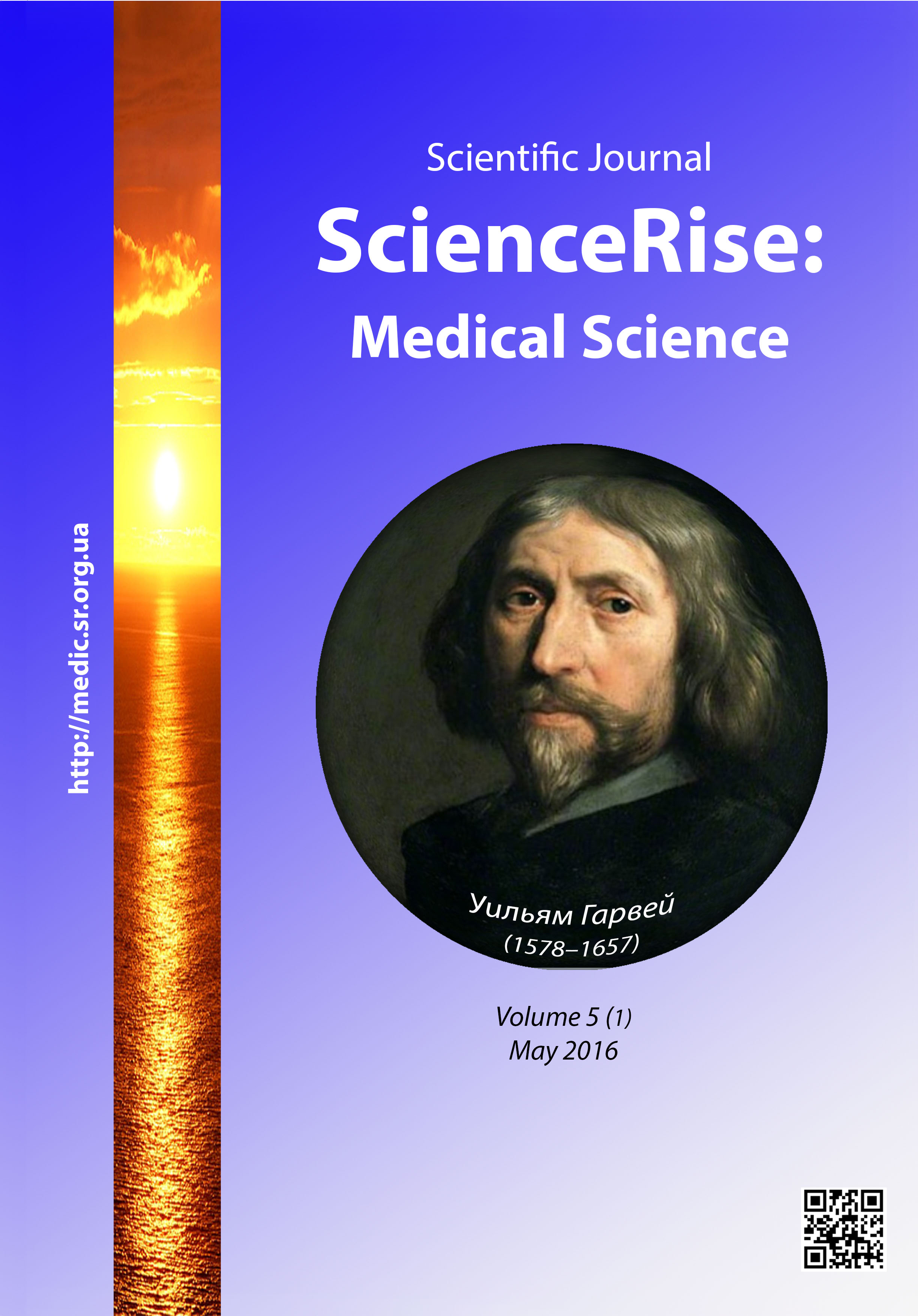Comparison of the traditional and nontrditional risk factors of heart desease in woman during perimenopause
DOI:
https://doi.org/10.15587/2519-4798.2016.70190Keywords:
perimenipause, cardiovascular risk, hypertonic disease, obesity, vascular-endothelial growth factor, dyslipidemiaAbstract
Aim of the work: to compare the frequency of occurrence and correspondence of the traditional risk factors of the cardiovascular disease to the nontraditional ones in women during perimenopause.
Materials and methods: there were examined 115 women with HD of II stage, 1-2 degree and obesity of I-II degree 50±3,5 years old. Depending on menopause status they were divided: 45 women in perimenopause, 50 women in menopause with 3 years period and 20 practically healthy women in perimenopause as a control group. VEGF concentration was determined by the method of immune-enzyme analysis.
Results: it was revealed that in the group of women in menopause was observed the reliable increase of the rate of risk factors of cardiovascular events. Combination of obesity, dyslipidemia, hyperglycemia and the high AP complicates the course of perimenipause period in women. The level of VEGF factor had not the reliable influence on indices of the lipid metabolism (general CS, triglycerides, CS LPLD, CS LPVLD) and BMI in women (p >0,05) in perimenopause period but had the influence of hyperglycemia in premenopause and early menopause periods except CS LPHD and BMI increase and also had the influence on the hyperglycemia level in women in perimenopause.
Conclusions: it was established that combination of such RF of CVD as obesity and dyslipidemia essentially complicate the clinical manifestations of climacteric syndrome in women in perimenopause that is proved by the high menopause indices. It was established that at combination of hyperglycemia, dyslipidemia, obesity and high VEGF level the risk of CVD on the SCORE scale increases in women in perimenopause. There was demonstrated the reliable influence of VEGF level on the hyperglycemia and CS LPHD indices in menopause (р<0,05), that gives grounds to consider VEGF as an additional nontraditional RF of CVD in these womenReferences
- Wang, X., Bots, M. L., Yang, F., Sun, J., He, S., Hoes, A. W. et. al (2016). A comparison of the prevalence and clustering of major cardiovascular risk factors in the Netherlands and China. European Journal of Preventive Cardiology. doi: 10.1177/2047487316648474
- Burns, J. W., Quartana, P. J., Bruehl, S., Janssen, I., Dugan, S. A., Appelhans, B. et. al (2014). Chronic pain, body mass index and cardiovascular disease risk factors: tests of moderation, unique and shared relationships in the Study of Women’s Health Across the Nation (SWAN). Journal of Behavioral Medicine, 38 (2), 372–383. doi: 10.1007/s10865-014-9608-z
- Peterson, L. M., Matthews, K. A., Derby, C. A., Bromberger, J. T., Thurston, R. C. (2016). The relationship between cumulative unfair treatment and intima media thickness and adventitial diameter: The moderating role of race in the study of women’s health across the nation. Health Psychology, 35 (4), 313–321. doi: 10.1037/hea0000288
- Sadeghi, M., Khalili, M., Pourmoghaddas, M. et. al (2012). The correlation between blood pressure and hot flashes in menopausal women. ARYA Atheroscler, 8 (1), 32–35.
- El Khoudary, S. R., Chen, H.-Y., Barinas-Mitchell, E., McClure, C., Selzer, F., Karvonen-Gutierrez, C. (2015). Simple Physical Performance Measures and Vascular Health in Late Midlife Women: The Study of Women’s Health Across the Nation. International Journal of Cardiology, 182, 115–120. doi: 10.1016/j.ijcard.2014.12.042
- Di Blasio, A., Di Donato, F., De Stefano, A., Gallina, S., Granieri, M., Napolitano, G. et. al (2011). Left ventricle relative wall thickness and plasma leptin levels. Menopause, 18 (1), 77–84. doi: 10.1097/gme.0b013e3181e57813
- Novella, S., Dantas, A. P., Segarra, G., Medina, P., Hermenegildo, C. (2012). Vascular Aging in Women: is Estrogen the Fountain of Youth? Frontiers in Physiology, 3. doi: 10.3389/fphys.2012.00165
- Wenger, N. K., Ouyang, P., Miller, V. M., & Bairey Merz, C. N. (2016). Strategies and Methods for Clinical Scientists to Study Sex-Specific Cardiovascular Health and Disease in Women. Journal of the American College of Cardiology, 67(18), 2186–2188. doi: 10.1016/j.jacc.2016.03.504
- Moreau, K. L., Hildreth, K. L., Meditz, A. L., Deane, K. D., Kohrt, W. M. (2012). Endothelial Function Is Impaired across the Stages of the Menopause Transition in Healthy Women. The Journal of Clinical Endocrinology & Metabolism, 97 (12), 4692–4700. doi: 10.1210/jc.2012-2244
- Zhang, J., Razavian, M., Tavakoli, S., Nie, L., Tellides, G., Backer, J. M. et. al (2012). Molecular Imaging of Vascular Endothelial Growth Factor Receptors in Graft Arteriosclerosis. Arteriosclerosis, Thrombosis, and Vascular Biology, 32 (8), 1849–1855. doi: 10.1161/atvbaha.112.252510
Downloads
Published
How to Cite
Issue
Section
License
Copyright (c) 2016 Марія Володимирівна Яресько

This work is licensed under a Creative Commons Attribution 4.0 International License.
Our journal abides by the Creative Commons CC BY copyright rights and permissions for open access journals.
Authors, who are published in this journal, agree to the following conditions:
1. The authors reserve the right to authorship of the work and pass the first publication right of this work to the journal under the terms of a Creative Commons CC BY, which allows others to freely distribute the published research with the obligatory reference to the authors of the original work and the first publication of the work in this journal.
2. The authors have the right to conclude separate supplement agreements that relate to non-exclusive work distribution in the form in which it has been published by the journal (for example, to upload the work to the online storage of the journal or publish it as part of a monograph), provided that the reference to the first publication of the work in this journal is included.









